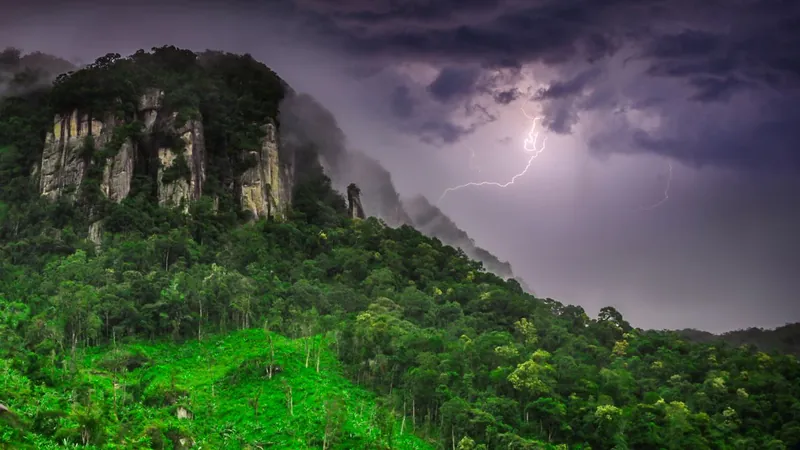
The Lightning-Wielding Wonder: How One Tropical Tree Uses Nature’s Fury to Survive and Thrive
2025-04-07
Author: Siti
The Hidden Resilience of the Tonka Bean Tree
Lightning is often viewed as a destructive force in forests, wreaking havoc by killing or damaging trees. However, in the lush lowland rainforests of Panama, one remarkable species of towering tropical tree appears to have turned this natural phenomenon to its advantage. The tonka bean tree, scientifically known as Dipteryx oleifera, has evolved to not only survive lightning strikes but to flourish because of them.
A groundbreaking study published on March 26 in the journal New Phytologist reveals that these resilient trees emerge unscathed from electrical encounters, while at the same time, lightning strikes decimate their competitors and the parasitic vines that cling to them. Research lead author Evan Gora, a forest ecologist at the Cary Institute of Ecosystem Studies, highlighted that while lightning spells disaster for many trees – particularly larger, older specimens that are crucial for carbon storage and biodiversity – the tonka bean tree shows a remarkable resilience.
Scientific Insights and Methodology
For over a decade, scientists have studied how lightning influences forest structure and species composition, providing insights into the resilience of these ecosystems amid climate change. Utilizing a sophisticated setup of electric field sensors and cameras, the team monitored nearly 100 lightning events in Panama's Barro Colorado Nature Monument. They developed a high-resolution detection system that accurately pinpointed where lightning struck, analyzing energy patterns captured by an extensive antenna array.
The results were striking: the Dipteryx oleifera consistently showed negligible damage post-strike. In fact, the study found that living in proximity to a tonka bean tree significantly increases the likelihood of mortality among competing plants. For example, each lightning strike resulted in the death of over 2.4 tons of nearby tree biomass, while nearly 80% of the parasitic vines infesting the tonka bean's canopy were eliminated.
Adaptations and Advantages
The secretive strength of these trees may lie in their physical structure. Research suggests that Dipteryx oleifera possesses high internal conductivity, allowing the lightning current to pass through without generating damaging heat—much like a well-insulated wire. Towering up to 130 feet (40 meters) and living for centuries, a single tonka bean tree might be struck by lightning at least five times during its life. Each lightning strike seems to clear the surrounding area, promoting healthy growth and access to sunlight.
The reproductive advantages are monumental, with researchers estimating that experiencing a lightning strike could yield a 14-fold increase in seed production for the tonka bean tree. This evolutionary edge means that while competing trees may perish, the tonka bean not only survives but thrives, reinforcing its dominance in the ecosystem.
Broader Implications and Future Research
Gregory Moore, a horticulturalist from the University of Melbourne who was not part of the study, affirmed that these findings likely extend beyond Dipteryx oleifera to other tree species as well, particularly in different forest types, like temperate woodlands. Moreover, he noted that in other contexts, such as Australian bushfires, certain tall trees are similarly adapted to survive repeated strikes.
As the research continues, Gora and his team plan to broaden their scope, exploring other forests in Africa and Southeast Asia to investigate whether lightning strikes confer similar benefits to other tree species. The realization that a tree can harness the raw power of nature—not just to survive but to gain an ecological advantage—could reshape our understanding of forest ecology and the resilience of plant life in the face of climate challenges.
Stay tuned as this fascinating study reveals the untold stories behind the survival tactics of some of the world’s most majestic trees!





 Brasil (PT)
Brasil (PT)
 Canada (EN)
Canada (EN)
 Chile (ES)
Chile (ES)
 Česko (CS)
Česko (CS)
 대한민국 (KO)
대한민국 (KO)
 España (ES)
España (ES)
 France (FR)
France (FR)
 Hong Kong (EN)
Hong Kong (EN)
 Italia (IT)
Italia (IT)
 日本 (JA)
日本 (JA)
 Magyarország (HU)
Magyarország (HU)
 Norge (NO)
Norge (NO)
 Polska (PL)
Polska (PL)
 Schweiz (DE)
Schweiz (DE)
 Singapore (EN)
Singapore (EN)
 Sverige (SV)
Sverige (SV)
 Suomi (FI)
Suomi (FI)
 Türkiye (TR)
Türkiye (TR)
 الإمارات العربية المتحدة (AR)
الإمارات العربية المتحدة (AR)